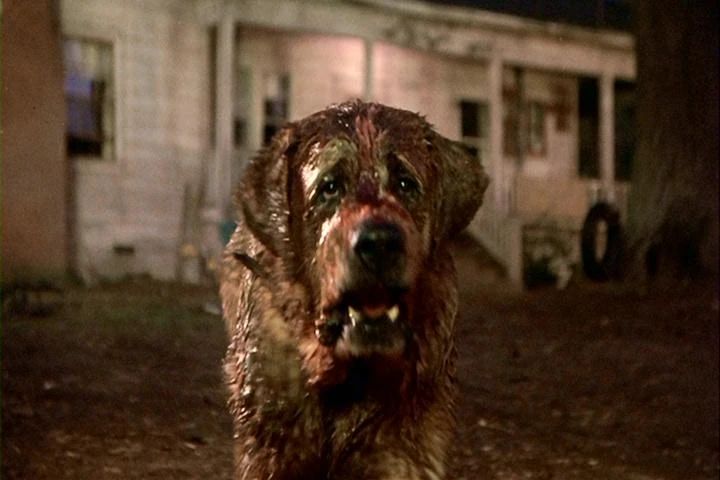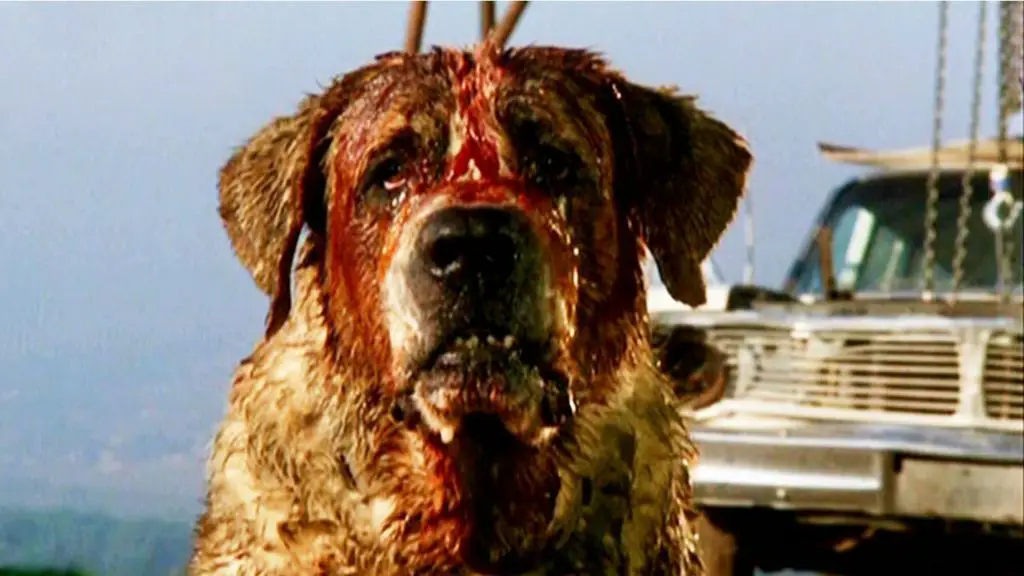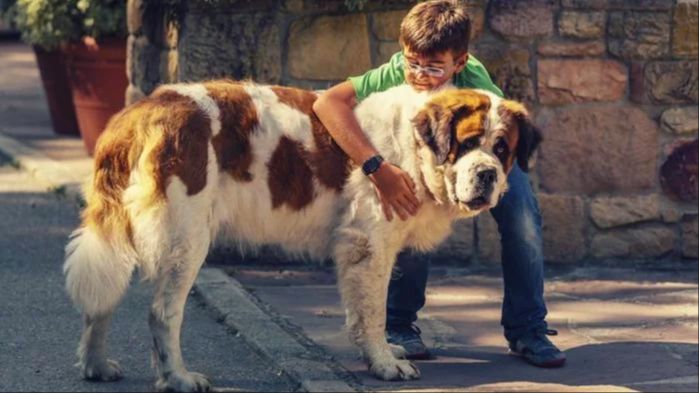Introducing Cujo and the Urban Legend
Cujo is a 1981 horror novel by Stephen King about a rabid Saint Bernard dog. The book tells the story of Cujo, a friendly St. Bernard who one day chases a rabbit into a hole and gets bitten on the nose by a rabid bat. This bite causes Cujo to become infected with rabies, which makes him violently aggressive.
In the book, Cujo traps a woman named Donna Trenton and her young son Tad inside their Ford Pinto. Cujo spends days trying to kill them while they are stuck in the hot car, too afraid to try to escape. The story builds suspense around whether Donna and Tad will survive being trapped by the crazed dog.
The book was adapted into a film in 1983, which follows the same basic plot. In the movie, Cujo is portrayed by multiple trained dogs and some animatronics. The film adaptation brought the frightening story of the rabid dog to life onscreen.
An urban legend emerged that in some scenes of the movie, instead of using a real dog or animatronic, the filmmakers put an actor in a dog costume to play Cujo. This fueled speculation that the entire Cujo character was actually just a person in costume rather than a real dog.

Origins of the Man in a Dog Suit Theory
The theory that Cujo was actually played by a man in a dog suit first emerged not long after the movie’s release in 1983. It gained particular prominence in the early days of online forums and discussion boards in the 1990s, where movie fans hotly debated the validity of the claim.
Those who supported the theory argued that the St. Bernard who played Cujo displayed unnatural body movements and facial expressions that seemed too human for an actual dog. They also claimed the close-up shots of Cujo snarling looked unrealistic and potentially fabricated using mechanical effects.
The earliest online discussions promoting the man-in-dog-suit theory appeared on Usenet groups like alt.horror and rec.arts.movies in the mid-1990s. Certain users insisted they could see the outline of a man’s jaw or human-like eyes whenever Cujo was shown up close.
The plausibility of using a costumed stuntman stemmed from the difficulties of working with real animal actors, especially for emotionally intense horror sequences. With limited CG effects at the time, some found it reasonable that a human performer assisted with certain complex scenes.
Overall, those who believed Cujo was a man in a suit felt the execution seemed slightly too unnatural to have been a real dog. The theory spread rapidly online in the early days of the internet, when movie special effects still seemed potentially prone to fakery.
Evidence Used to Support the Theory

Some of the most commonly cited evidence from Cujo that theorists claim shows a man in a dog suit includes the following:
In the scene where Cujo first chases Tad and Vic in the car, his movements appear too fluid and coordinated for a real dog, suggesting a man in a suit. According to one Reddit user, “the way he moved was too natural for a real dog.” [1]
In close-up shots, Cujo’s facial expressions seem unnaturally human-like and his eyes don’t look realistic. Some say it resembles a person in a mask more than a real dog. [2]
The sounds Cujo makes, including growls and barks, sound dubbed in rather than coming directly from the dog on screen. According to theorists, this could be because it was actually a person in a costume.
In scenes where Cujo is stationary, it appears the dog is panting far less than would be expected for a St. Bernard in hot weather. Some claim this suggests a human was inside the costume.
During the most violent attack scenes, Cujo’s movements seem too controlled and almost choreographed compared to a real violent dog. Theorists argue a human in a suit would be able to carefully execute the scenes without actual harm.
Counter-Evidence Against the Theory
While the man in a dog suit theory persists, there is substantial evidence that discounts this urban legend and confirms Cujo was achieved through animal training and effects.
According to behind the scenes footage, the production used multiple trained Saint Bernard dogs to play Cujo (ScreenRant). The dogs were gentle in real life, but trainers used methods like smearing them with p âté to make them appear vicious and rabid on camera. Mechanics were also built into the Cujo dog head to control movements of the snout and fangs during close-ups.
Additionally, animal experts note the movements and mannerisms of the dogs in Cujo closely match real canine behavior, debunking the idea it could be a human in a costume (Inquisitive Canine). The dogs snarl, bark, run, bite, and lunge in ways difficult for a human to mimic convincingly.
The child actor who played Tad Trenton also confirmed in interviews that the Cujo dogs were real and trained to act ferocious. But between takes they would return to a calm demeanor and receive affection and rewards from trainers.
While clever editing helped enhance Cujo’s rabid appearance, the preponderance of evidence confirms canine actors were primarily used to create the terrifying dog, not an actor in a suit.
Expert Opinions on the Validity of the Theory
Several members of Cujo’s cast and crew have stated that the man in a dog suit urban legend is false. According to the film’s animal trainer Karl Lewis Miller, “We used five St. Bernards in the film. There were no men in dog suits.” He explained that the dogs were trained using positive reinforcement and that no animals were harmed during filming.
Dee Wallace, who played Donna Trenton, said in an interview, “That was a real dog, I promise you. They would never have gotten me in the car with a man in a dog suit!” She described working closely with the dogs and developing relationships with them over the course of production.
Special effects technician Robert Clark also denied the rumor, stating, “I worked on making the dogs appear vicious and rabid. At no point did we ever put a man in a costume.” He cited the use of camera tricks and editing to make the dogs seem more aggressive and detailed the complex animatronics used for certain scenes.
Behind the Scenes of Cujo’s Production

The dog who played Cujo in the 1983 film was actually portrayed by several different St. Bernard dogs, along with animatronic prop dogs created by special effects designer Robert Bromley-Davenport. According to Screenrant.com, five St. Bernards were used during filming – one female named Bessy and four males named Mushroom, Bo, Bob-O, and Billy.
Each dog was trained by renowned Hollywood animal trainer Karl Lewis Miller. Miller used positive reinforcement techniques to teach the dogs to snarl, growl, and lunge aggressively on command while ensuring their safety on set. Treats, affection, and play were used to reward the dogs for their performances.
Miller also trained the dogs to hit specialized markers during scenes. He would have them lunge towards a trainer’s arm wrapped in protective gear to simulate attacking without making harmful contact, as described by Inquisitivecanine.com. Clever editing and camera angles helped make the trained behaviors seem vicious and realistic on screen.
For more dangerous stunts, animatronic stand-ins were used rather than putting the live dogs in peril. The prop Cujo heads were remotely controlled off-screen by crew members to achieve movements like snarling and biting during complex action sequences. This allowed the film to minimize risk and accomplish scenes that would be impossible with a real dog.
Using Animal Actors in Movies
Horror films often rely on animals, especially dogs and wolves, to portray terrifying creatures and monsters on screen. Trainers use a variety of techniques to get canine actors to perform the specific actions needed for frightening scenes.
One common approach is utilizing well-trained dogs who are responsive to verbal and hand commands from trainers just off camera. The 1976 film The Omen featured several scenes with vicious dogs attacking people, accomplished through training the canine actors to act aggressively on cue. According to the Guardian, director Richard Donner worked extensively with dog trainers to achieve the frightening effects safely.
Another technique is editing together footage of real wolves or wolf-dog hybrids with shots of actors pretending to interact with them. The iconic transformation scene in An American Werewolf in London relied on editing real wolf footage to create the illusion of a man turning into a beast. For Cujo, they may have combined shots of a live Saint Bernard with a stunt performer in a dog costume for certain scenes.
Special effects like animatronic dogs and computer-generated imagery can also bring creature effects to life onscreen without putting animals in harm’s way. Advances in CGI and robotics have enabled more realistic CGI animals and animatronics for recent horror films like The Thing and The Wolfman.
Urban Legends and Movie Theories
Urban legends often emerge around popular movies as fans speculate about behind-the-scenes details or try to explain ambiguous or strange events in the films. According to ScreenCrush (https://screencrush.com/movie-urban-legends/), movie urban legends feed people’s desire to find hidden meanings and solve cinematic mysteries. They allow fans to become creative participants in extending the storyworld. Other examples of famous movie urban legends include a munchkin actor committing suicide in the background of The Wizard of Oz (https://www.imdb.com/search/keyword/?keywords=urban-legend) and the hoverboards in Back to the Future Part II being real.
These legends propagate as fans share speculative theories and details that are difficult to confirm or debunk definitively. The emergence of the internet and social media has allowed these urban myths to spread faster and wider than ever before. While many urban legends are false or exaggerated, they testify to the imaginative power of movies to inspire engagement, discussion, and continued mystery long after the credits roll.
The Legacy and Impact of Cujo
Cujo was met with mixed critical reviews upon its release, but has since gone on to become a cult horror classic. Some critics at the time found the film too “predictable” and “manipulative”, while others praised its tense atmosphere and genuinely scary villain ([1]). Horror author Stephen King himself was reportedly pleased with the adaptation of his novel. While not a major box office hit initially, Cujo has developed a reputation as one of the better Stephen King adaptations, with some calling it “one of the most effective horror films of the 80s” ([2]).
Cujo had a significant influence on the horror genre, demonstrating that an ordinary household pet like a dog could be terrifying if turned into a ruthless killer. It helped pave the way for later animal attack films like The Birds and Jaws by showing the dramatic potential of an animal villain. Cujo also emphasized the horror of feeling trapped and isolated, which would become common tropes in many horror movies to follow. Its messy combination of family drama with gruesome horror violence made it stand out for its time. Overall, Cujo made a memorable impact despite initial mixed reviews, and is now considered an iconic horror film.

Conclusion – Man or Beast?
After examining the origins of the man in a dog suit theory about Cujo, looking at the evidence for and against it, and considering expert opinions, what’s the final verdict on this urban legend? While an interesting idea, the preponderance of evidence suggests Cujo was indeed a real trained dog, not a man in a costume. Accounts from the set confirm they used trained dogs, and the aggressive movements and behavior match what real dogs are capable of, not a human in a suit. Theorists have not provided irrefutable proof for their claims. Does some reasonable doubt remain? Perhaps, but not enough to outweigh the firsthand accounts and logic against it. Urban legends add intrigue and mystery to popular culture, so the man in a dog suit theory will likely persist. But based on available information, Cujo was most likely a real canine actor, not a costumed hoax.
